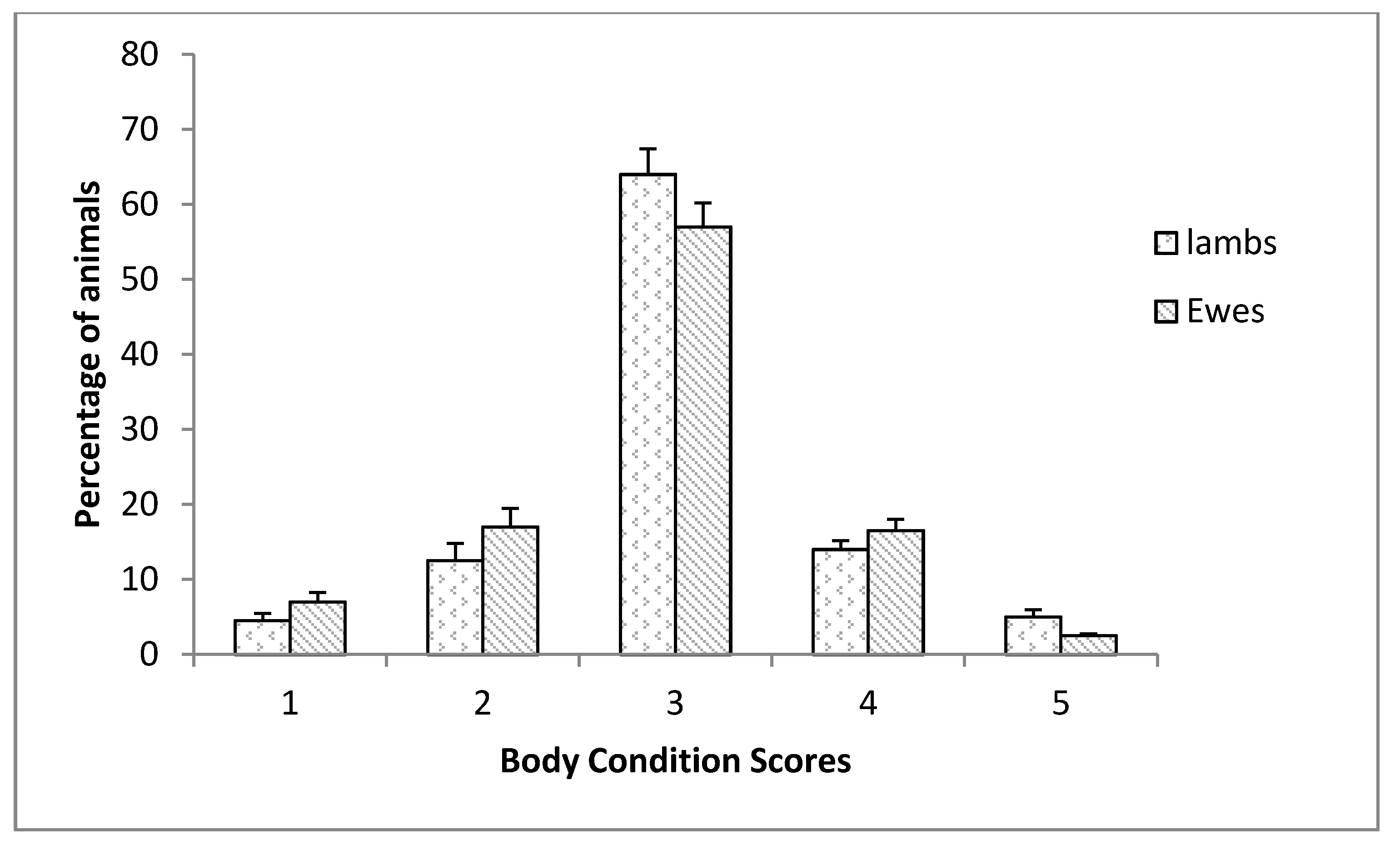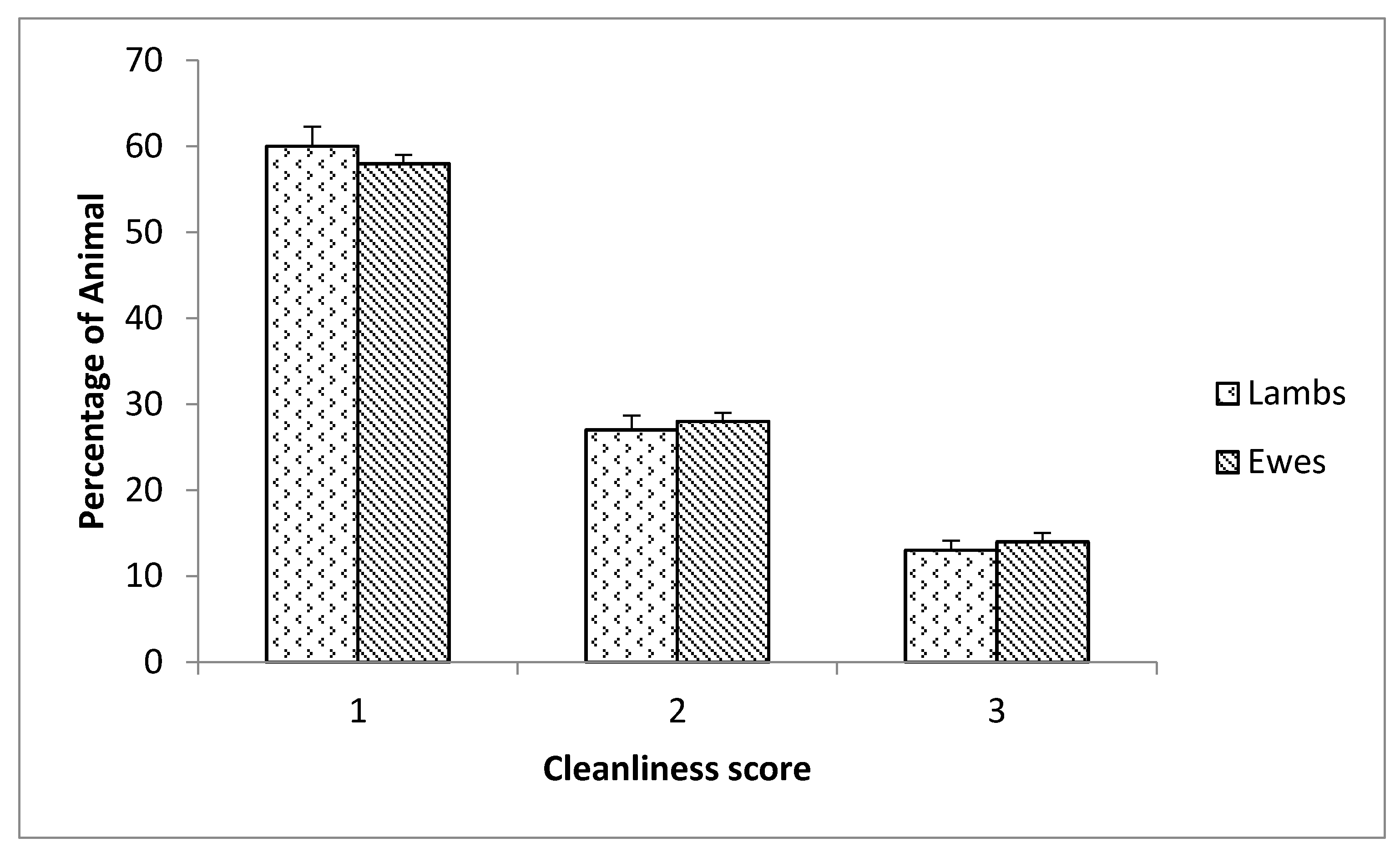Assessment of Meat-Type Sheep Welfare Using Animal-Based Measures
Abstract
:Simple Summary
Abstract
1. Introduction
2. Materials and Methods
2.1. Study Sites and Animals
2.2. Welfare Indicator Assessments
2.3. Statistical Analysis
3. Results
3.1. Body Condition Score
3.2. Cleanliness
3.3. Health
3.4. Animal-Human Interactions
4. Discussion
4.1. Body Condition
4.2. Cleanliness
4.3. Health
4.4. Animal-Human Interactions
5. Conclusions
Author Contributions
Funding
Institutional Review Board Statement
Data Availability Statement
Acknowledgments
Conflicts of Interest
References
- Ibidhi, R.; Frija, A.; Jaouad, M.; Ben Salem, H. Typology analysis of sheep production, feeding systems and farmers strategies for livestock watering in Tunisia. Small Rumin. Res. 2018, 160, 44–53. [Google Scholar] [CrossRef]
- OEP. Available online: http://www.oep.nat.tn/index.php/en/donnees-sectorielles/41-productions (accessed on 17 February 2020).
- Blokhuis, H.J.; Jones, R.B.; Geers, R.; Miele, M.; Veissier, I. Measuring and monitoring animal welfare: Transparency in the foodproduct quality chain. Anim. Welf. 2003, 12, 445–455. [Google Scholar]
- Main, D.C.J.; Kent, J.P.; Wemelsfelder, F.; Ofner, E.; Tuyttens, F.A.M. Applications for methods of on-farm welfare assessment. Anim. Welf. 2003, 12, 523–528. [Google Scholar]
- Cook, C. Basal and stress response cortisol levels and stress avoidance learning in sheep (Ovis ovis). N. Z. Veter. J. 1996, 44, 162–163. [Google Scholar] [CrossRef]
- Destrez, A.; Deiss, V.; Leterrier, C.; Boivin, X.; Boissy, A. Long-term exposure to unpredictable and uncontrollable aversive events alters fearfulness in sheep. Animal 2013, 7, 476–484. [Google Scholar] [CrossRef] [PubMed] [Green Version]
- Dwyer, C.; Lawrence, A. Introduction to animal welfare and the sheep. In The Welfare of Sheep; Dwyer, C., Ed.; Springer: Berlin/Heidelberg, Germany, 2008; pp. 1–40. [Google Scholar]
- Goddard, P. Welfare assessment in sheep. InPractice 2011, 33, 508–516. [Google Scholar] [CrossRef]
- Cochran, W.G. Sampling Techniques; John Wiley & Sons, Inc.: New York, NY, USA, 1977. [Google Scholar]
- AWIN. AWIN Welfare Assessment Protocol for Sheep. Available online: http://www.animal-welfare-indicators.net/site/flash/pdf/AWINProtocolSheep.pdf (accessed on 17 February 2020).
- Phythian, C.J.; Mullan, S.; Butterworth, A.; Lambton, S.; Ilić, J.; Burazerović, J.; Burazerović, E.; Leach, K.A. A pilot survey of farm animal welfare in Serbia, a country preparing for EU accession. Vet. Med. Sci. 2017, 3, 208–226. [Google Scholar] [CrossRef]
- Phythian, C.J.; Toft, N.; Cripps, P.J.; Michalopoulou, E.; Winter, A.C.; Jones, P.H. Inter-observer agreement, diagnostic sensitivity and specificity of animal-based indicators of young lamb welfare. Animal 2013, 7, 1182–1190. [Google Scholar] [CrossRef] [PubMed] [Green Version]
- Phythian, C.J.; Toft, N.; Cripps, P.J.; Michalopoulou, E.; Winter, A.C.; Jones, P.H. Reliability of indicators of sheep welfare as-sessed by a group observation method. Vet. J. 2012, 193, 257–263. [Google Scholar] [CrossRef] [PubMed]
- Napolitano, F.; De Rosa, G.; Ferrante, V.; Grasso, F.; Braghieri, A. Monitoring the welfare of sheep in organic and con-ventional farms using an ANI 35L derived method. Small Rumin. Res. 2009, 1, 49–57. [Google Scholar] [CrossRef]
- Caroprese, M.; Casamassima, D.; Rassu, S.P.G.; Napolitano, F.; Sevi, A. Monitoring the on-farm welfare of sheep and goats. Ital. J. Anim. Sci. 2009, 8, 343–354. [Google Scholar] [CrossRef]
- Calavas, D.; Sulpice, P.; Lepetitcolin, E.; Bugnard, F. Assessing the accuracy of BCS in ewes under field conditions. Vet. Res. 1998, 29, 129–138. [Google Scholar] [PubMed]
- Waiblinger, S.; Menke, C.; Fölsch, D. Influences on the avoidance and approach behaviour of dairy cows towards humans on 35 farms. Appl. Anim. Behav. Sci. 2003, 84, 23–39. [Google Scholar] [CrossRef]
- Webster, A.J.F. Continuous measurement of heart rate as an indicator of the energy expenditure of sheep. Br. J. Nutr. 1967, 21, 769–785. [Google Scholar] [CrossRef] [PubMed]
- Statistical Analysis System; Release 9.4; SAS Institute Inc.: Cary, NC, USA, 2012.
- Keeling, L.J. Defining a framework for developing assessment systems. In An Overview of the Development of the Welfare Quality Project Assessment Systems. Welfare Quality Report n: 12; Keeling, L.J., Ed.; Cardiff University: Cardiff, UK, 2009; pp. 1–7. [Google Scholar]
- Verbeek, E.; Waas, J.R.; Oliver, M.H.; McLeay, L.M.; Ferguson, D.M.; Matthews, L.R. Motivation to obtain a food reward of pregnant ewes in negative energy balance: Behavioral, metabolic and endocrine considerations. Horm. Behav. 2012, 62, 162–172. [Google Scholar] [CrossRef] [PubMed]
- Karaku, F.; Atmaca, M. The effect of ewe body condition at lambing on the growth of lambs and colostral specific gravity. Arch. Anim. Breed. 2016, 59, 107–112. [Google Scholar] [CrossRef]
- Banchero, G.; Quintans, G. Lamb vigour of merino ewes in high and low body condition with or without a lupin supple-ments during the last two weeks of pregnancy. In Reproduction in Domestic Ruminants V, Proceedings of The Seventh International Symposium on Reproduction in Domestics Ruminants, Wellington, New Zealand, 7 Auguest 2006; Nottingham University Press: Nottingham, UK, 2007; p. 495. [Google Scholar]
- Keinprecht, H.; Pichler, M.; Pothmann, H.; Huber, J.; Iwersen, M.; Drillich, M. Short term repeatability of body fat thickness measurement and body condition scoring in sheep as assessed by a relatively small number of assessors. Small Rumin. Res. 2016, 139, 30–38. [Google Scholar] [CrossRef]
- Stubsjoen, S.M.; Hektoen, L.; Valle, P.S. Assessment of sheep welfare using on-farm registrations and performance data. Anim. Welf. 2011, 20, 239–251. [Google Scholar]
- Sevi, A. Animal-based measures for welfare assessment. Ital. J. Anim. Sci. 2009, 8, 904–911. [Google Scholar] [CrossRef]
- Winter, A.C.; Arsenos, G. Diagnosis of white line lesions in sheep. InPractice 2009, 31, 17–21. [Google Scholar] [CrossRef]
- Lees, A.M.; Sullivan, M.L.; Olm, J.C.W.; Cawdell-Smith, A.J.; Gaughan, J.B. A panting score index for sheep. Int. J. Biometeorol. 2019, 63, 973–978. [Google Scholar] [CrossRef] [PubMed]
- Lovatt, F. Clinical examination of sheep. Small Rumin. Res. 2010, 92, 72–77. [Google Scholar] [CrossRef]
- Waiblinger, S.; Boivin, X.; Pedersen, V.; Tosi, M.V.; Janczak, A.M.; Visser, E.K.; Jones, R.B. Assessing the human-animal rela-tionship in farmed species: A critical review. Appl. Anim. Behav. Sci. 2006, 101, 185–242. [Google Scholar] [CrossRef] [Green Version]
- Boivin, X.; Nowak, R.; Desprès, G.; Tournadre, H.; Le Neindre, P. Discrimination between shepherds by lambs reared under artificial conditions. J. Anim. Sci. 1997, 75, 2892–2898. [Google Scholar] [CrossRef] [PubMed]
- Hemsworth, P.H.; Rice, M.; Karlen, M.G.; Calleja, L.; Barnett, J.L.; Nash, J.; Coleman, G.J. Human–animal interactions at abattoirs: Relationships between handling and animal stress in sheep and cattle. Appl. Anim. Behav. Sci. 2011, 135, 24–33. [Google Scholar] [CrossRef]
- Komesaroff, P.A.; Esler, M.; Clarke, I.J.; Fullerton, M.J.; Funder, J.W. Effects of estrogen and estrous cycle on glucocorticoid and catecholamine responses to stress in sheep. Am. J. Physiol. Content 1998, 275, E671–E678. [Google Scholar] [CrossRef]
- Hemsworth, P.H.; Coleman, G.J. Human-Livestock Interactions: The Stockperson and the Productivity and Welfare of Intensively Farmed Animals; CAB International: Wallingford, UK, 1998. [Google Scholar]
- Seabrook, M.F.; Bartle, N.C. Environmental factors influencing the production and welfare of farm animals-human factors. In Farm Animals and the Environment; Phillips, C.J.C., Piggins, D., Eds.; CAB International: Wallingford, UK, 1992; pp. 111–130. [Google Scholar]


| Welfare Principles | Welfare Criteria | Welfare Indicators |
|---|---|---|
| Good feeding | Appropriate nutrition | Body condition score |
| Good housing | Comfort around resting | Fleece cleanliness |
| Good health | Absence of diseases, injuries, and pain | Lameness, respiratory disorders, and rear and dirtiness |
| Appropriate behavior | Expression of social behavior | Familiar human approach |
| Variables | Percentage of Ewes with | ||
|---|---|---|---|
| No Problem | Moderate | Severe | |
| Respiratory rate | 89.75 ± 7.24 | 8.1 ± 0.21 | 2.15 ± 0.14 |
| Lesions | 86.95 ± 6.13 | 9.7 ± 0.33 | 3.35 ± 0.23 |
| Dirtiness | 17.2 ± 3.2 | 57.3 ± 5.17 | 12.75 ± 1.33 |
| Lameness | 84.87 ± 5.27 | 10.48 ± 1.12 | 4.65 ± 0.57 |
| Approach Test | Withdrawal Distance (m) | Heart Rate (bpm) | ||||
|---|---|---|---|---|---|---|
| Min | Mean | Max | Min | Mean | Max | |
| Novel person | 7.5 | 10.47 ± 1.23 | 13.78 | 63.5 | 128.4 ± 1.42 | 208.7 |
| Farmer | 5.24 | 8.12 ± 0.97 | 10.17 | 58.3 | 97.8 ± 6.45 | 197.6 |
Publisher’s Note: MDPI stays neutral with regard to jurisdictional claims in published maps and institutional affiliations. |
© 2021 by the authors. Licensee MDPI, Basel, Switzerland. This article is an open access article distributed under the terms and conditions of the Creative Commons Attribution (CC BY) license (https://creativecommons.org/licenses/by/4.0/).
Share and Cite
M’Hamdi, N.; Darej, C.; Attia, K.; Guesmi, H.; Znaïdi, I.E.A.; Bouraoui, R.; M’Hamdi, H.; Marzouki, L.; Ayadi, M. Assessment of Meat-Type Sheep Welfare Using Animal-Based Measures. Animals 2021, 11, 2120. https://doi.org/10.3390/ani11072120
M’Hamdi N, Darej C, Attia K, Guesmi H, Znaïdi IEA, Bouraoui R, M’Hamdi H, Marzouki L, Ayadi M. Assessment of Meat-Type Sheep Welfare Using Animal-Based Measures. Animals. 2021; 11(7):2120. https://doi.org/10.3390/ani11072120
Chicago/Turabian StyleM’Hamdi, Naceur, Cyrine Darej, Khaoula Attia, Hajer Guesmi, Ibrahim El Akram Znaïdi, Rachid Bouraoui, Hajer M’Hamdi, Lamjed Marzouki, and Moez Ayadi. 2021. "Assessment of Meat-Type Sheep Welfare Using Animal-Based Measures" Animals 11, no. 7: 2120. https://doi.org/10.3390/ani11072120
APA StyleM’Hamdi, N., Darej, C., Attia, K., Guesmi, H., Znaïdi, I. E. A., Bouraoui, R., M’Hamdi, H., Marzouki, L., & Ayadi, M. (2021). Assessment of Meat-Type Sheep Welfare Using Animal-Based Measures. Animals, 11(7), 2120. https://doi.org/10.3390/ani11072120







